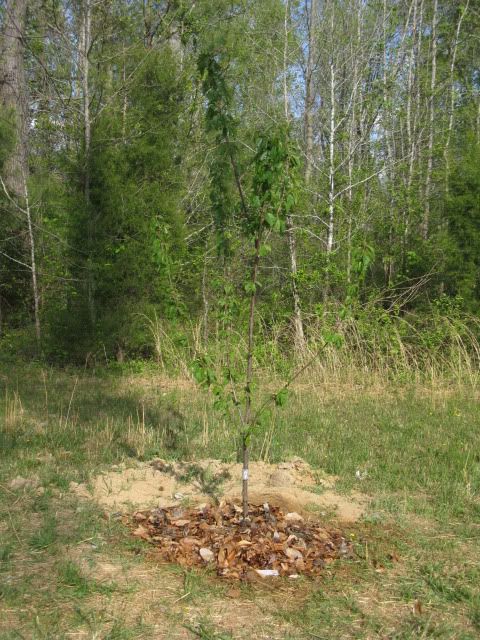Planted in March

This is a Methley Plum tree purchased from the local Southern States.
A Redhaven Peach tree purchased from the local Southern States.
 And two Goldhaven Cherry trees, also from the local Southern States.
And two Goldhaven Cherry trees, also from the local Southern States. Planted in April
The local nurseries did not have an Elberta Peach tree, so I ordered one online from Gurney's......it's a smidge less than what I expected (live and learn, I suppose).
Each of the trees was buried with a mix of 2 parts coir and 1 part aged chicken and rabbit poop. Local soil fills the remainder of the hole and we mulched with leaf debris from the woods. As they grow, they will create a nook providing shade for our beehives. As they get bigger, I intend to add Siberian Pea Shrub as the mid-layer in this section and I have not yet decided on the low level yet, but I think it will include clover. Clover already grows well amongst the grasses in this area and is great for the bees.
The trees are planted in the northeast corner of the unwooded portion of our property. They are at the top of a gradual rise that moves down southward. The Methley Plum and Elberta Peach trees are along the northern edge of woods just west of the beehives. The Redhaven Peach tree is south of the Methley Plum and southwest of the beehives. The Goldhaven Cherry twins are along the eastern edge of the woods south of the beehives. I plan to start our permaculture at this corner and work out south and west until the entire property is complete.
Having friends who already know a bit about this stuff is certainly beneficial. One of my friends was kind enough to provide this diagram for me regarding how to care for our trees.
 "The brown ring is the small mound you make around the base of the tree that follows the natural drip-line of the tree. This is where you plant your "green" mulch.(the beautifully drawn light blue squiggles, respectfully).
"The brown ring is the small mound you make around the base of the tree that follows the natural drip-line of the tree. This is where you plant your "green" mulch.(the beautifully drawn light blue squiggles, respectfully).Inside the ring is where the brown and green mulch go to rest. Alternating them as best you can.
As the tree grows (about every 3-5 ft diameter of expansion you add a new, bugger and wider green mulch ring.
Eventually, the tree will start producing enough of its own mulch to let the floor level alone. It is then you can start adding the final touches of your longer term (I call them "end game" species) under story trees and plants."
He went on to describe how a cluster of trees will meet up and the mulch layers will overlap:
"A random cluster about midway to maturity...
Notice how I show one that the ring is not complete...once the drip lines start touching you can open up the rings in any given cluster. This is also a good sign for starting long term understory design implementation. (As another example, in this cluster, you could also open up the area in the middle of the other 3 trees.)"
My knowledgeable friend is starting his own site on sustainable living that will include more information on permaculture practices. He expects to launch his site in June. Please follow his Facebook page for updates.







No comments:
Post a Comment